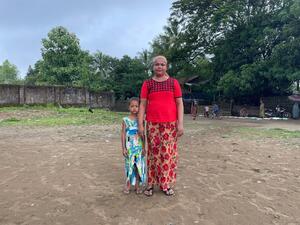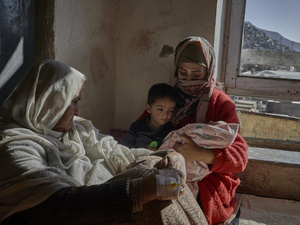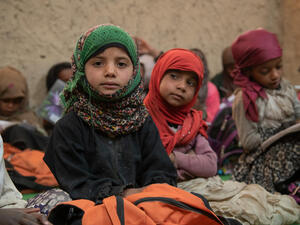Displaced Congolese return to camps near Goma
Displaced Congolese return to camps near Goma

Internally displaced Congolese on the road in North Kivu. Thousands have returned to camps in the Mugunga area.
GOMA, Democratic Republic of the Congo, November 15 (UNHCR) - Thousands of Congolese have been flowing back to the camps for internally displaced people (IDPs) that they had fled from earlier this week in Democratic Republic of the Congo's North Kivu province.
By Thursday morning, some 20,000 people had returned to Mugunga I and Mugunga II camps, located 15 kilometres west of the North Kivu capital of Goma. The figure accounts for about 80 percent of those who fled the two sites early Tuesday after dawn skirmishes in surrounding hills between government forces and suspected renegade troops.
The fighting died down later Tuesday and people soon started returning to their homes in the IDP camps. At least 28,000 IDPs out of some 38,000 sheltered at the Mugunga I, Mugunga II and Lac Vert sites had fled.
"Tuesday's events, when tens of thousands of Congolese fled within hours, show the extreme volatility of North Kivu. There is a high risk of civilians becoming victims of violence and severe human rights abuses," said UNHCR Senior Emergency Preparedness & Response Officer Germaine Bationo.
The IDPs at the Mugunga camps returned to widespread scenes of looting, with their shelters stripped of the UNHCR-distributed plastic sheeting used to protect them from the rain and sun. Some seem to have been manipulated by profiteers into selling their food and non-food items. "IDPs are now coming to us to ask what they will do without plastic sheeting," said Bationo.
The UN refugee agency handed out 7,000 pieces of precious plastic sheeting in the two Mugunga camps earlier this month, but on Thursday it had all gone, UNHCR field officers said. The aid item has a good resale value and on Thursday morning market traders in Goma were selling plastic sheeting at US$12 apiece - UNHCR spends $7.00 per piece of plastic sheeting.
UN aid workers believe much of the looting was organized and systematic. Meanwhile, those returning to the camps have no protection from the torrential rain pounding the region and they also lack sufficient food.
UN agencies and non-governmental organizations working in Goma are now planning new assistance to the IDPs, some of whom had been displaced as many as five times before fleeing to the Mugunga area earlier this year.
As calm returned to the area, UNHCR on Wednesday resumed the transfer of displaced people from Lac Vert to Buhimba - an IDP site established by UNHCR near Goma in early October. The operation had been launched on November 7 as part of a strategy to improve the living conditions of IDPs in the area.
Also on Wednesday, the government launched information campaigns on local radio urging IDPs to return to the camps. They promised transport for IDPs who were too tired to walk back to their temporary homes in the Mugunga area. UNHCR staff toured Bulengo and Buhimba camps with loudhailers urging IDPs to return.
Local authorities positioned open trucks along the road linking Goma and Mugunga to transport IDPs back to the camps. Other IDPs made their own way back to the sites using footpaths.
The build-up of military forces and repeated clashes in North Kivu since December 2006 have led to the worst internal displacement in the area since the end of the civil war in 2003. Some 375,000 Congolese have been forced to leave their homes in the province since last December, including more than 160,000 in the last two months alone. There are some 800,000 IDPs in the province.
UNHCR is urging all parties to refrain from attacks on internally displaced people and civilians, and to find a negotiated solution for the prolonged violence that continues to plague North Kivu and its population.









